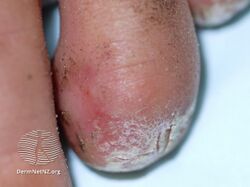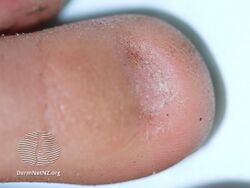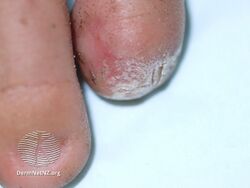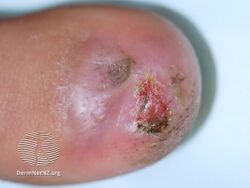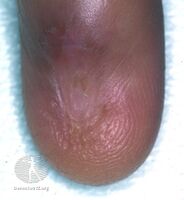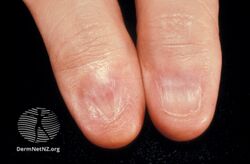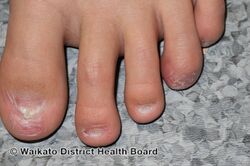Anonychia
Jump to navigation
Jump to search
| Anonychia | |
|---|---|
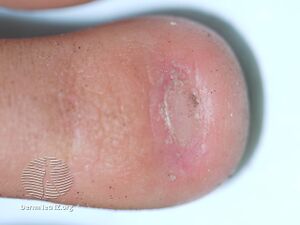 | |
| Anonychia | |
| Specialty | Dermatology |
| Symptoms | Absent or small nails[1] |
| Causes | Congenital ectodermal defect, ichthyosis, severe infection, severe allergic contact dermatitis, self-inflicted trauma, Raynaud phenomenon, lichen planus, epidermolysis bullosa, severe exfoliative diseases[2] |
| Diagnostic method | Appearance[2] |
| Frequency | Rare[2] |
Anonychia is the absence of finger or toe nails due to failure to develop them.[1]
It may be the result of a congenital ectodermal defect, ichthyosis, severe infection, severe allergic contact dermatitis, self-inflicted trauma, Raynaud phenomenon, lichen planus, epidermolysis bullosa, or severe exfoliative diseases.[2] It can also occur in severe psoriasis.[1] It may occur on its own due to a mutation in the RSPO4 gene.[3] It occurs in nail-patella syndrome.[1] It may be associated with the drug etretinate.[4]
It is rare.[2]
Congenital form
This is rare and is usually due to mutations in the R-spondin 4 (RSPO4) gene which is located on the short arm of chromosome 20 (20p13).[5]
Additional images
-
Anonychia
-
Anonychia
-
Anonychia
-
Anonychia
-
Anonychia
-
Anonychia
-
Anonychia
See also
References
- ↑ 1.0 1.1 1.2 1.3 MacGilchrist, Claire (2020). "3. The skin and nails in podiatry". In Burrow, J. Gordon; Rome, Keith; Padhiar, Nat (eds.). Neale's Disorders of the Foot and Ankle (9th ed.). Elsevier. p. 52. ISBN 978-0-7020-6504-0. Archived from the original on 2023-06-30. Retrieved 2023-05-16.
- ↑ 2.0 2.1 2.2 2.3 2.4 James, William D.; Elston, Dirk; Treat, James R.; Rosenbach, Misha A.; Neuhaus, Isaac (2020). "33. Diseases of the skin appendages". Andrews' Diseases of the Skin: Clinical Dermatology (13th ed.). Edinburgh: Elsevier. p. 782. ISBN 978-0-323-54753-6. Archived from the original on 2023-06-30. Retrieved 2023-05-16.
- ↑ Bellet, Jane Sanders (2021). "Paediatric nail disorders". In Lipner, Shari (ed.). Nail Disorders: Diagnosis and Management, An Issue of Dermatologic Clinics. Philadelphia: Elsevier. pp. 232–233. ISBN 978-0-323-70923-1. Archived from the original on 2022-05-08. Retrieved 2023-05-16.
- ↑ Johnstone, Ronald B. (2017). "2. Diagnostic clues and "need-to-know" items". Weedon's Skin Pathology Essentials (2nd ed.). Elsevier. p. 31. ISBN 978-0-7020-6830-0. Archived from the original on 2023-06-30. Retrieved 2023-05-31.
- ↑ Khan TN, Klar J, Nawaz S, Jameel M, Tariq M, Malik NA, Baig SM, Dahl N (2012) Novel missense mutation in the RSPO4 gene in congenital hyponychia and evidence for a polymorphic initiation codon (p.M1I). BMC Med Genet 13(1):120
External links
| Classification |
|---|
